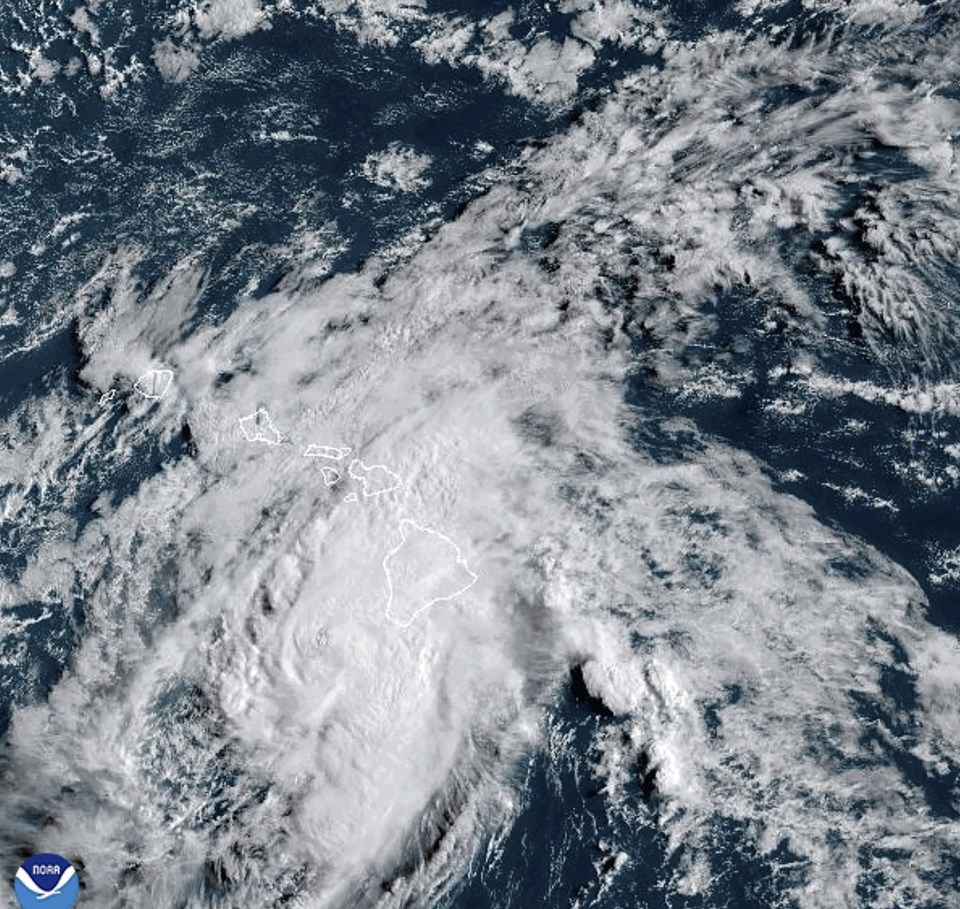HONOLULU (AP) — Three swirled over the Pacific Ocean on Monday, including Tropical Storm Hone, which brought heavy rain to Hawaii, Hurricane Gilma, which was gaining strength, and Tropical Storm Hector, which was churning westward, far off the coast of southern tip of Baja California.
The biggest impacts from Tropical Storm Hone (pronounced hoe-NEH) were rainfall and flash floods that resulted in road closures, downed power lines and damaged trees in some areas of the Big Island, said William Ahue, a forecaster at the Central Pacific Hurricane Center in Honolulu.
By midday Monday, Hone was 280 miles (450 kilometers) west-southwest of Honolulu with maximum sustained winds of 65 mph (110 kph). It was moving west at 13 mph (20 kph).
“No major damage that we know of yet,” Big Island Mayor Mitch Roth said. “No injuries that we know of at this point.”
One family had to be evacuated Sunday because of flooding, Roth said.
Four Big Island schools were closed because of power outages and flooded roads from Hone. Hawaiian Electric said the utility restored power to most customers who experienced outages. And state transportation officials warned Monday that the Hilo airport may be busier because of added flights to make up for weekend cancelations.
Julia Neal, the owner of a bed-and-breakfast located on a former sugar plantation in Pahala, on the Big Island, said she and some guests were “experiencing tropical storm winds and heavy pounding rain through the night.” She added that “Hone was also a gift in a way because we have been experiencing a lot of drought.”
On Sunday, floods closed Highway 11 between Kona and Hilo, and a higher-altitude alternative, the Cane Road, was closed by flooding as well, isolating properties like the Aikane Plantation Coffee Co. outside Pahala, where owner Phil Becker said his 10-inch (25-centimeter) rain gauge overflowed in the deluge.
“We’ve got quite a lot of flood damage, the gulches are running full speed ahead and they’re overflowing the bridges, so we’re trapped down here. We can’t get in or out,” Becker said.
Becker said his plantation is off the grid, powered with batteries charged by solar electricity, and his family is safe, so they have no reason to evacuate. The weather may even prove beneficial: “We’ve been in a drought situation so the coffee is probably loving all this rain,” he said.
The access road leading to the Big Island summit of Mauna Kea will be closed until at least Wednesday because of damage from Hone. Strong winds and heavy rain opened large cracks on the road, according to the University of Hawaii, which manages the top of the mountain.
Rangers helped 17 visitors who were stranded below the visitor information station by a large tree on Saturday, the university said.
Hone, whose name is Hawaiian for “sweet and soft,” poked at memories still fresh of last year's deadly blazes on Maui, which were fueled by . Red flag alerts are issued when warm temperatures, very low humidity and stronger winds combine to raise fire dangers. Most of the archipelago is already abnormally dry or in drought, according to the U.S. Drought Monitor.
The Aug. 8, 2023, blaze that torched the was the in more than a century, with 102 dead. Dry, overgrown helped spread the fire.
The cause of the Lahaina blaze is still under investigation, but by bare electrical wire and leaning power poles toppled by the strong winds. The state’s two power companies, Hawaiian Electric and the Kauai Island Utility Cooperative, were prepared to shut off power if necessary to reduce the chance that live, damaged power lines could start fires, but they later said the safety measures would not be necessary as Hone blew past the islands.
In the eastern Pacific Ocean, Hurricane Gilma intensified Monday into a strong Category 2 hurricane with maximum sustained winds at 110 mph (175 kph). Gilma was located about 1,160 miles (1,865 kilometers) east of Hilo, Hawaii, and moving west at 8 mph (13 mph).
Gilma was forecast to increase in forward speed, but decrease in intensity, the National Hurricane Center said. It was still expected to be a hurricane when it reaches the central Pacific basin on Tuesday.
Farther to the east, Tropical Storm Hector also gained strength Monday. Hector had top sustained winds of 50 mph (65 kph). It was centered about 1,125 miles (1,805 kilometers) west-southwest of the southern tip of Mexico's Baja peninsula and was moving west-northwest at 10 mph (17 kph).
Roth, the Big Island's mayor, said residents should still be concerned about these storms. With the ground already saturated, additional rain could be problematic, he said.
“It's never too early to start protecting your house,” he said.
___
Walker reported from New York.
Jennifer Sinco Kelleher And Julie Walker, The Associated Press




